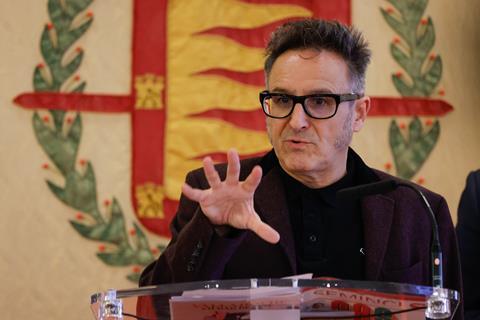
José Luis Cienfuegos is ready to launch his first edition as director at one of Spain’s oldest film events, Valladolid International Film Week (October 21-28) also known as the Seminici.
Previously in charge of the Gijón and Seville film festivals, Cienfuegos’ Valladolid is embracing new voices and has enhanced industry activities as it continue the work of finding new audiences for independent cinema while debating film heritage in the 21st century.
He talks to Screen about this year’s programme and why Valladolid is ramping up its industry activities to appeal international professionals.
With the fresh eyes of a newcomer, what role do you believe Valladolid plays on the international film festival circuit?
For international professionals, one of the attractions is the connection with the Spanish distribution market.
At this edition we are also proud to celebrate film heritage with conferences and debates about the future of the restoration and dissemination of film heritage. Within the framework of Spain’s presidency of the European Union, we are hosting an event with the heads of film archives and international festivals from Cannes Classics to Il Cinema Ritrovato in Bologna. They will discuss how to programme the cinema of the past. This desire to honour film history is the DNA of Valladolid.
What is your vision for fhe festival’s industry activities?
The idea is to make Valladolid more and more internationally relevant. We have increased the number of days gathering film industry professionals, the number of screenings, panels and roundtables. In line with Valladolid’s traditional focus on independent distribution we are hosting the third edition of the Independent Film Market (MERCI), an initiative to boost relations between independent distributors, exhibitors, television channels and platforms.
The goal is to help films get to theatres in the best of environments. The space devoted to culture and film coverage in the media is decreasing and we have to work closely with distributors and exhibitors to give visibility to productions. With that in mind the main Spanish independent distributors, independent exhibitors and chain owners as well as platform and TV programmers from Spain will gather to network and discuss the search for new audiences.
And also, concerning exhibitors, Europa Cinemas [the network of theatres specialising in European and auteur cinema] will bring together exhibitors from all over the continent to take part in the Innovation and Audience Development Laboratory from October 25 to 28.
What have been your priorities putting together your first edition?
Looking for balance, taking on board the long and rich history of the Seminci while looking at the future, and embracing the dialogue between established and new voices in the Spanish and international industries.
I think this is evident in the titles selected in competition from Ken Loach’s The Old Oak, Agnieszka Holland’s Green Border and Mario Bellocchio’s Kidnapped to names like Alice Rohrwacher (La Chimera) or Betrand Bonello (The Beast) who had never come before, as well as a first-time feature director Molly Manning Walker with How To Have Sex. Andrew Haigh, who has already been in Valladolid with 45 Years, is now here with All Of Us Strangers.
This is our aim in the other sections too. We are interested in new voices and very much invested in bringing back younger audiences too. We have a significant number of world premieres of Spanish productions in the official section [Antonio Méndez Esparza’s Something Is About To Happen; Manuel Martín Cuenca’s Andrea’s Love; Carlota Nelson’s Eyes Of The Soul, Patricia Font’s The Teacher Who Promised The Sea and Paula Ortiz’s Teresa] that make Valladolid a key showcase for the local industry. This is especially true in terms of the Goya awards campaigns, as we come at the end of the year, after Malaga in March and San Sebastian in September. The Goyas ceremony will be held in Valladolid next February.
What are the most significant changes you want to implement as director of the Seminci?
My team and I took over in spring, only a few months ago, and hit the ground running. Programming will gradually and naturally evolve, it has already done so and will keep doing so in future editions. I think it is noticeable a new team is in charge. In the official selection but also throughout other sections of the festival. An example is the introduction of names like Kleber Mendonça Filho and his essay Pictures Of Ghosts, Claire Simon’s Our Body or Wang Bing’s Youth (Spring) in the section Time of History, devoted to non-fiction features and shorts.
Throughout the programme we want to encourage the connection and knowledge of the new wave of filmmakers in Spain and abroad and reach out to new audiences. In terms of structure, a section like Spanish Cinema aiming to spotlight Spanish films to international press has disappeared but the presence of Spanish productions is strong throughout.
Doc España, with documentaries that used to have a more traditional approach to non-fiction, has disappeared too. We wanted to focus on the competitive sections and cut down the number of titles.
What trends have you spotted when programming?
Something quite significant is the fact that in Meeting Point, devoted to first or second features, 75 per cent of the films selected are directed by women. Change is not just coming. Change is here and in three or four years I believe it won’t even be necessary to think of or apply gender quotas when programming.
There has also been a change in the programming teams at festivals that is relevant, having gender parity in the selecting committees, like in our case. We have looked for a more holistic and global perspective when selecting films and finding the best section for them.























No comments yet